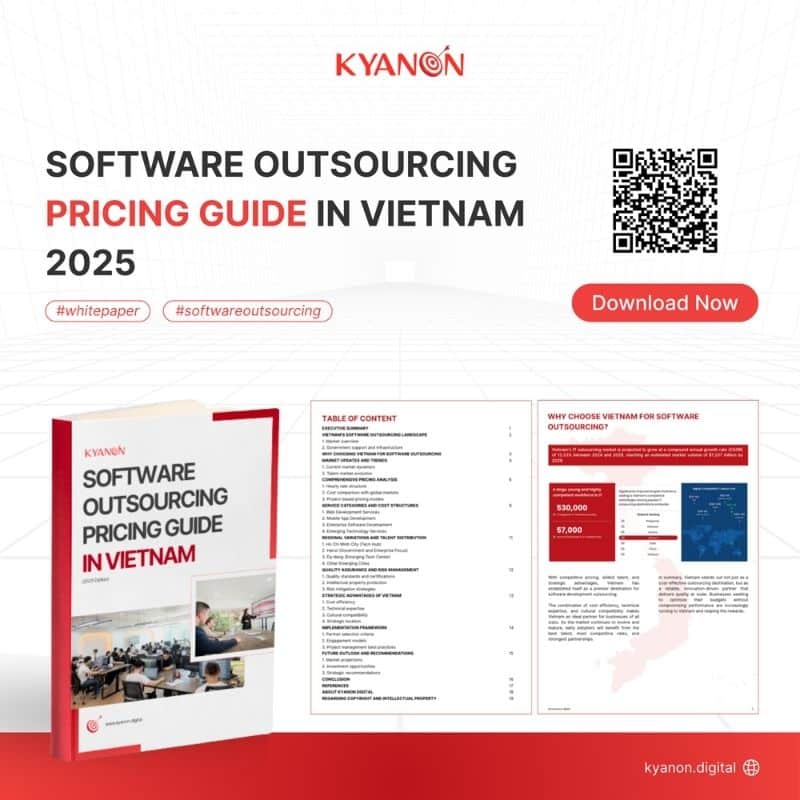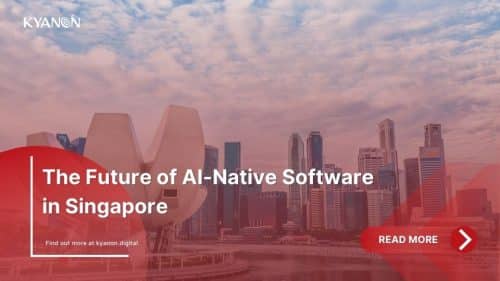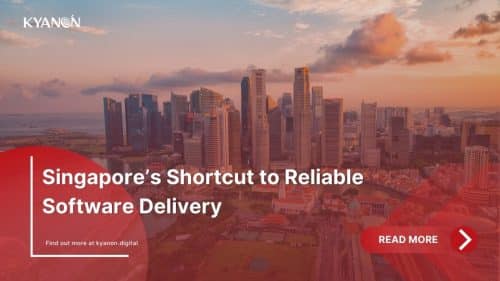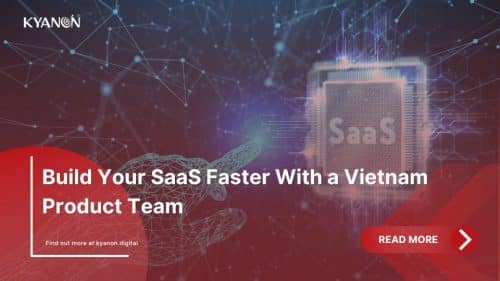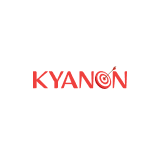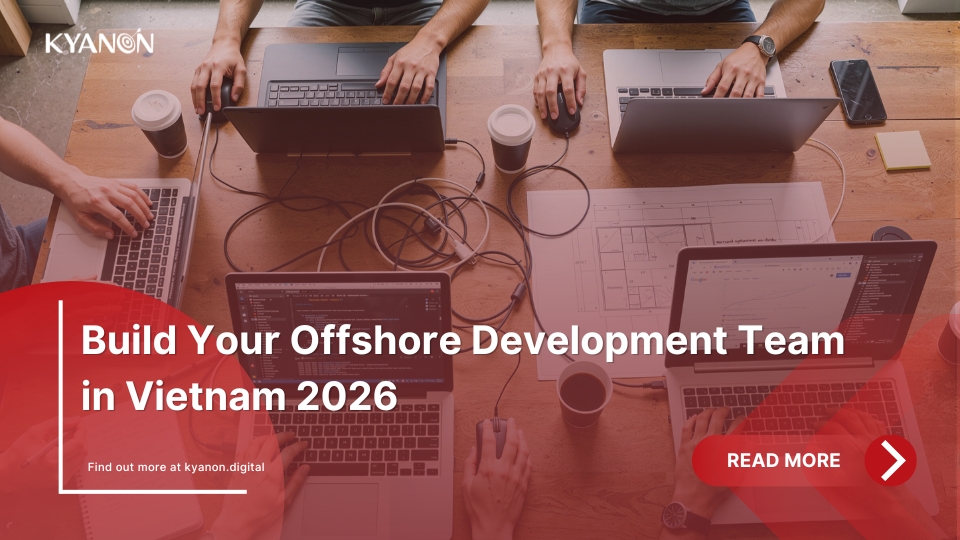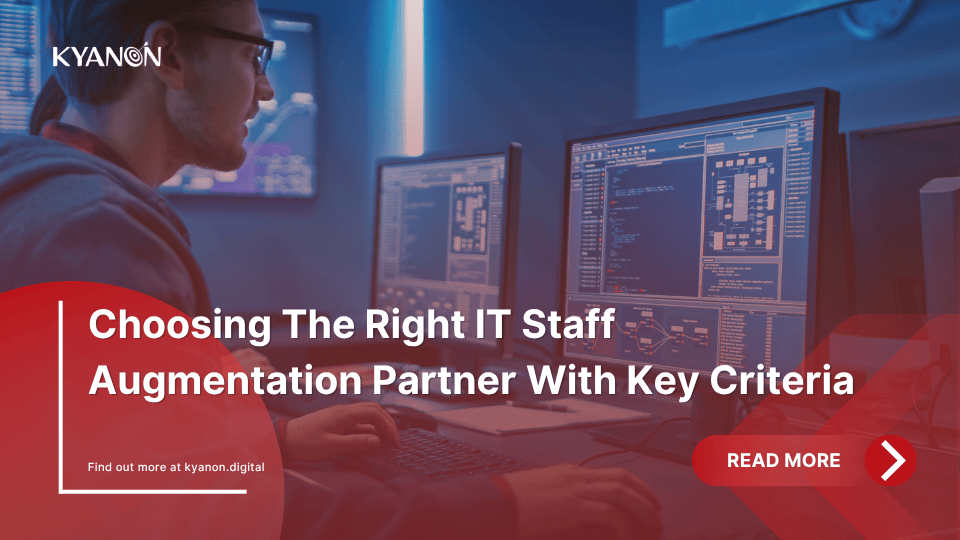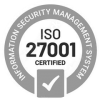In today’s rapidly accelerating digital landscape, staying competitive means scaling your tech teams smartly. Two prominent models often come into play: IT staff augmentation and outsourcing. But which one truly fits your business needs? This article will delve into both, helping you make an informed decision.
Further reading:
- Types Of It Staff Augmentation All You Need To Know
- How to Ensure Seamless Collaboration with Your Dedicated Team
What Is Staff Augmentation?
Let’s clarify the staff augmentation meaning. In simple terms, staff augmentation is a flexible outsourcing strategy where you temporarily add external skilled professionals to your in-house team. These individuals work under your direct management to fill specific skill gaps or boost your team’s capacity for a certain period.
There are different types of staff augmentation depending on your business needs—ranging from short-term support for urgent tasks, to long-term collaboration for ongoing projects, or highly specialized expertise to tackle complex challenges. Understanding these types helps you choose the right approach to scale efficiently while maintaining full control over your team.
Benefits of IT Staff Augmentation
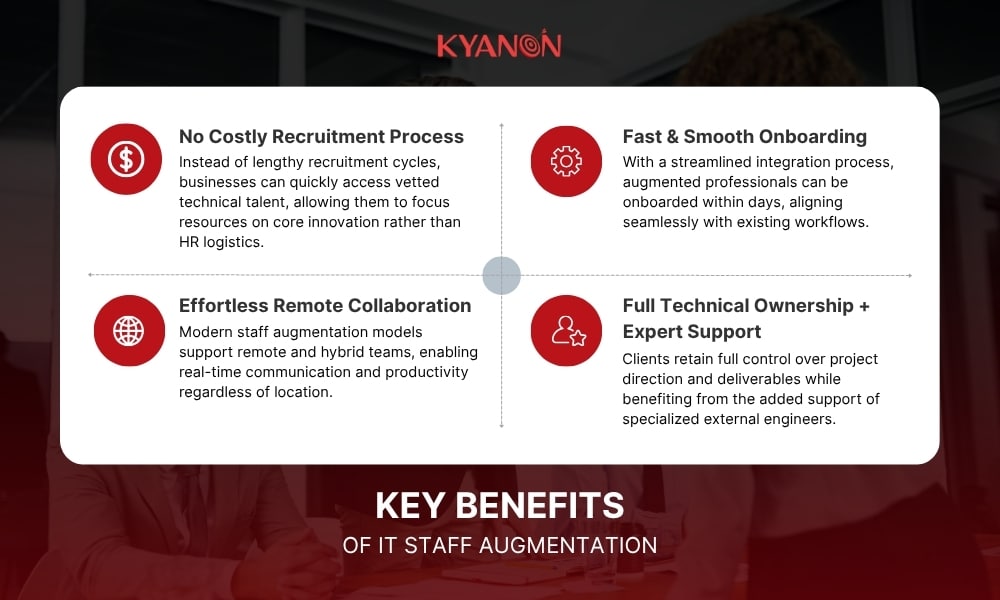
No Costly Recruitment Process
Instead of investing time and money in lengthy hiring cycles, companies can instantly access pre-vetted technical talent. This allows internal teams to focus on driving innovation and delivery rather than dealing with recruitment logistics. Depending on the types of staff augmentation you choose – be it project-based, skill-based, or time-based – you can scale your team efficiently without the overhead of traditional hiring.
Fast and Smooth Onboarding
With a streamlined onboarding process, augmented staff can be integrated into your workflow within days. Whether you’re using commodity-based, skill-based, or highly specialized staff augmentation, each type offers different levels of flexibility to ensure minimal disruption and faster ramp-up times, allowing your project to move forward without delay.
Effortless Remote Collaboration
Modern staff augmentation supports remote and hybrid team setups. Augmented professionals can work seamlessly with your team, using real-time communication tools to maintain productivity regardless of geographical location. This adaptability across different types of staff augmentation makes it easier to build high-performing distributed teams.
Full Technical Ownership and Expert Support
You retain full control over your project’s direction and deliverables while gaining access to specialized external expertise. By choosing the right type of staff augmentation for your needs, you strengthen your internal capabilities and ensure high-quality, on-time delivery, all while staying agile and cost-effective.
Transform your ideas into reality with our services. Get started today!
Our team will contact you within 24 hours.
Types of IT Staff Augmentation
Understanding the different types of staff augmentation is essential to selecting the right model for your organization’s unique needs. Whether you’re looking to move fast, access niche expertise, or scale sustainably, choosing the right type of augmentation ensures better alignment between your business goals and technical capabilities.
There are two main ways to categorize staff augmentation:
A. Based on purpose or duration
B. Based on skill level or talent type
A. Based on Purpose or Duration
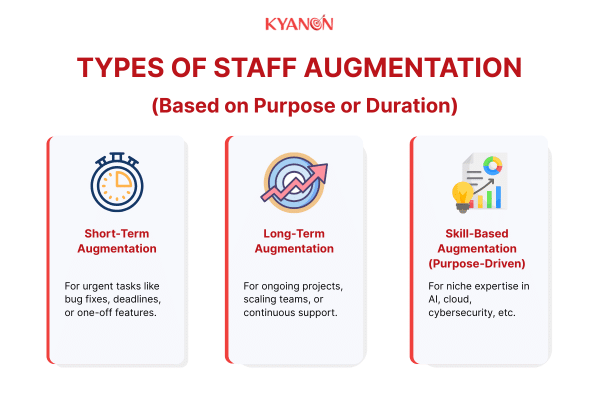
This approach looks at why and for how long you need to bring in external talent:
- Short-Term Augmentation: Used when you need to respond to immediate, time-sensitive challenges – such as meeting a tight deadline, handling unexpected team absences, or shipping a high-priority feature.
→ Best for urgent bug fixes, fast-tracked launches, or one-off deliverables.
- Long-Term Augmentation: Ideal when you need consistent external support over several months or even years. This model is common in product-based companies aiming to scale delivery capacity without committing to permanent hires.
→ Great for ongoing development, feature expansion, or system maintenance.
- Skill-Based Augmentation (Purpose-Driven): Applied when your in-house team lacks specific expertise critical to a project. Think of scenarios like adopting a new cloud platform, securing an app with advanced cybersecurity, or integrating AI capabilities.
→ Perfect for short- to mid-term initiatives that require deep, targeted knowledge.
B. Based on Skill Level or Talent Type
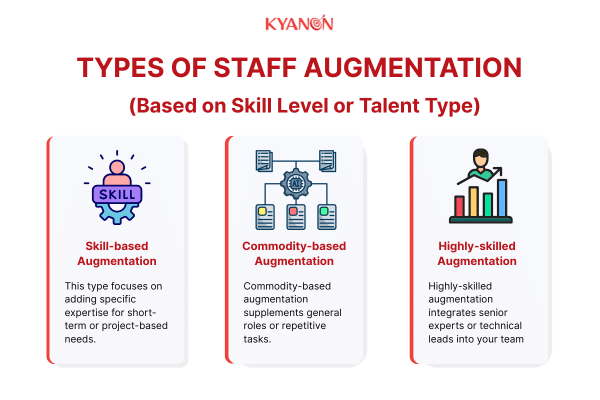
This classification focuses on the level of expertise the augmented professionals bring to your team:
- Commodity-Based Augmentation
Involves generalist roles such as junior developers, QA testers, or support staff. These professionals handle routine tasks that don’t require highly specialized skills.
→ Cost-effective, scalable, and easy to onboard for repetitive or volume-driven work.
- Skill-Based Augmentation (Talent-Driven)
Refers to engaging professionals with specific technical capabilities that are difficult to find or not available in-house. These individuals usually work on short-term, high-impact tasks.
→ Commonly used for PoCs, audits, or integrating emerging technologies.
- Highly-Skilled Augmentation
Brings in top-tier talent such as senior engineers, architects, or technical consultants. They not only execute but also guide technical direction, mentor your team, and improve engineering processes.
→ Ideal for strategic projects, digital transformation, or leading a critical delivery stream.
Pro Tip:
The most effective staff augmentation strategies match the type of augmentation to the complexity and stage of your project. For example, startups may benefit from skill-based augmentation early on, while enterprises might lean on highly-skilled augmentation for governance and innovation at scale.
IT Staff Augmentation vs. Outsourcing: A Detailed Comparison
Here’s a comparison table highlighting key differences, specifically looking at a “Dedicated Team” model (often a form of outsourcing) versus “Team Augmentation” (which is staff augmentation):
| Category | Team Augmentation | Dedicated Team |
| Best for | – When you need extra developers to fill skill gaps.
– Helps meet deadlines by adding resources. |
– Best for long-term projects needing continuous updates and support.
– Useful when you need experts to handle part of an ongoing project. |
| Example Projects | An e-commerce business adds extra developers during peak shopping seasons to handle high traffic and launch new features. | A SaaS company that needs regular updates hires a dedicated team to maintain and improve its platform |
| Cost Considerations | Costs vary based on demand; ideal for short-term or fluctuating needs. | Higher upfront costs but more cost-effective over time due to the team’s deep understanding of the project. |
| Risk Sharing | The company takes on most of the risk, managing the project while the vendor provides extra staff. | Both the company and vendor share risks. The company controls the team, while the vendor handles admin tasks. |
| Team Integration | New staff need time to adjust and integrate.
Temporary workers may struggle to fully adapt to your workflows. |
The team works closely with your company’s processes and tools.
Dedicated team ensures better communication. Greater retention of knowledge and expertise. |
| Project Management | You handle most management tasks, including assigning work, setting priorities, tracking progress, and ensuring quality. | The vendor manages the team but keeps you updated regularly.
Some project coordination may still be required on your side. |
Staff Augmentation vs. Software Development Consulting
When planning a tech initiative, companies often face a crucial decision: whether to augment their internal team with additional resources or to engage a software development consulting partner. Each approach offers distinct advantages depending on the business context, goals, and available capabilities.
The table below provides a side-by-side comparison to help you determine which model best fits your needs:
| Category | Staff Augmentation | Software Development Consulting |
| Best for | Projects that require additional execution power or niche technical skills temporarily | Companies lacking in-house expertise and seeking end-to-end solutions or strategic guidance. |
| Example Projects | Adding developers to accelerate product sprints, temporary DevOps support | – Building software from scratch
– Designing software architecture – Digital transformation initiatives |
| Cost Considerations | Generally more cost-effective for long-term execution needs | Higher upfront cost due to strategic input, but can lead to better long-term ROI. |
| Risk Sharing | You retain most of the project risk and responsibility | Risks are shared; the consultant is often accountable for outcomes and strategic alignment. |
| Team Integration | Fully embedded within your internal team; often onboarded like employees | Consultants may work independently or collaboratively, with clearer scopes and processes. |
| Project Management | You manage tasks, timelines, and outcomes | Managed by the consulting partner, who may handle planning, execution, and delivery. |
IT Staff Augmentation vs. Project Outsourcing
When planning software development initiatives, organizations must choose between augmenting their existing team or fully outsourcing the project to an external partner. Both models can be effective, but they differ significantly in terms of cost, control, risk, and team dynamics.
The comparison below highlights key differences to help you make an informed decision:
| Category | IT Staff Augmentation | Full Project Outsourcing |
| Best for | – When you need extra developers to fill skill gaps.
– Helps meet deadlines by adding resources. |
Ideal when you need a full software solution but lack internal IT resources to manage it. |
| Example Projects | An e-commerce business adds extra developers during peak shopping seasons to handle high traffic and launch new features. | A healthcare provider without an internal IT team outsources the development of a custom EHR system to a software company. |
| Cost Considerations | Costs vary based on demand; ideal for short-term or fluctuating needs. | Lower initial cost, but total expenses may rise if changes or extra features are required after delivery. |
| Risk Sharing | The company takes on most of the risk, managing the project while the vendor provides extra staff. | The vendor is fully responsible for the project, but the company risks working with an unreliable vendor. |
| Team Integration | New staff need time to adjust and integrate.
Temporary workers may struggle to fully adapt to your workflows. |
Minimal integration with your internal team and development processes. |
| Project Management | You handle most management tasks, including assigning work, setting priorities, tracking progress, and ensuring quality. | Minimal management required.
The vendor is responsible for delivering the project on time and meeting quality standards, with penalties for delays. |
When to Choose Each Model
Choosing between IT staff augmentation vs. outsourcing depends on your project scope, internal resources, timeline, and the level of control you want over development. Each model brings distinct advantages depending on your situation.
Choose Staff Augmentation if:
- You need to fill skill gaps quickly: Your internal team lacks certain capabilities—such as mobile development, DevOps, or cybersecurity—and you need temporary support without going through a lengthy hiring process.
- You want to maintain full control over the project: Staff augmentation allows you to directly manage augmented developers as part of your in-house team. You retain visibility into daily progress and can make real-time decisions.
- You’re looking to scale internal capabilities flexibly: Whether for a product launch, seasonal demand, or feature expansion, staff augmentation helps you scale up or down without long-term commitments.
- You need specific expertise for a limited time: Ideal for proof-of-concept phases, audits, migrations, or specialized initiatives where hiring permanent staff isn’t necessary.
- You already have a strong internal product or engineering team: When your core team is established, you can easily integrate external talent to accelerate delivery without disrupting internal workflows.
Choose Outsourcing (Dedicated Team or Project-Based) if:
- You need end-to-end delivery for a clearly defined project: Ideal for projects such as building an MVP, overhauling a legacy system, or developing a standalone solution. The external team takes full responsibility for execution and delivery.
- You lack the internal expertise or bandwidth to manage the project: If your team is at capacity or doesn’t have experience leading software delivery, outsourcing provides executional maturity and technical leadership.
- You want to minimize operational overhead: Outsourcing vendors handle recruitment, infrastructure, team management, and delivery risks—allowing your internal team to focus on core business functions.
- You’re dealing with a non-core initiative: Outsourcing helps deliver internal tools or support systems without shifting focus from your main product or strategic priorities.
- You require faster time-to-market with minimal ramp-up: With access to ready-made teams and standardized workflows, outsourcing partners can often begin immediately, accelerating your delivery timeline.
Why Partner with Kyanon Digital?
We’re a Tech Partner, Not Just a Recruiter
We build your team strategically, aligning talents with your software vision and roadmap, not just filling job descriptions. With ongoing upskilling and expert support from our Center of Excellence, your talent stays ahead of challenges and delivers results.
Comprehensive Talent Ecosystem
Kyanon Digital’s talent ecosystem encompasses over 50,000 technology professionals:
- Internal Talent Core: 500+ professionals
- K-Fresh Program: Nurturing Future Digital Leaders from 18 Universities in Vietnam
- External Talent Network: 15,000+ premium candidates
- Partner Network: 1,000+ trusted partners
Your One-Stop Talent Impact Solution
We manage everything from talent acquisition to HR management for your tech workforce, freeing your team to focus on core business and innovation.
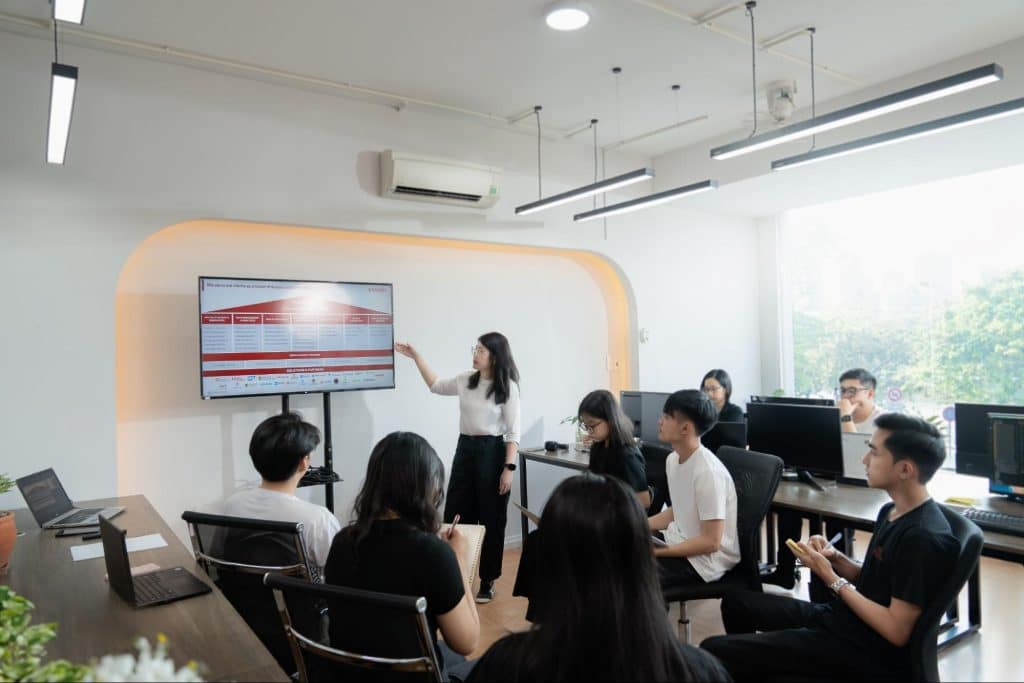
Conclusion
There’s no one-size-fits-all answer when choosing between staff augmentation and outsourcing. Staff augmentation offers enhanced control and flexibility, integrating talent directly into your team. Outsourcing can provide speed and cost efficiency for well-defined outcomes, particularly when you prefer a hands-off approach to project execution.
The best advice? Carefully assess your in-house strengths, project complexity, timeline, budget, and your desired level of control before making a decision.
Need help finding the right model for your business?
Contact Kyanon Digital today for a tailored consultation or a scalable solution that fits your exact needs.
Key Takeaways:
- Staff augmentation integrates external talent into your team under your direct management.
- Outsourcing (including dedicated teams or project-based) hands over significant project responsibility to an external vendor.
- The various types of staff augmentation cater to different needs, from filling short-term skill gaps to long-term strategic scaling.
- Choose staff augmentation for control, flexibility, and rapid skill acquisition within your existing structure.
- Choose outsourcing for end-to-end project delivery, especially when internal capacity is limited or you want to offload non-core projects.
Your shortcut to Vietnam’s outsourcing costs and key market insights.Get the Vietnam Software Outsourcing Pricing Guide 2025

Why work with Kyanon Digital?
With deep experience serving Fortune 500 companies, we deliver tailored, high-impact solutions that meet the unique demands of global enterprises.
Our 500+ IT experts—spanning consulting, project management, technical architecture, software engineering, QA, DevOps, and AI/ML—are committed to excellence in every project.
Certified under ISO 9001, our quality-first approach guarantees precision, reliability, and continuous improvement.
ISO 27001-certified, we integrate robust security into every process, leveraging advanced technologies to protect your data against evolving threats.
Share your requirements with us!


